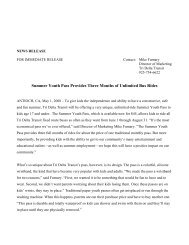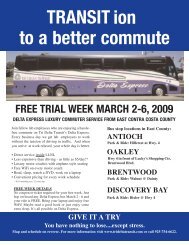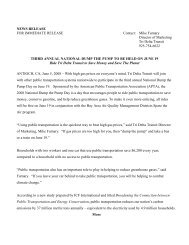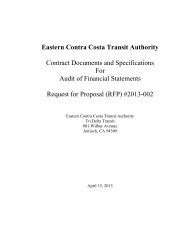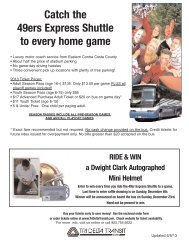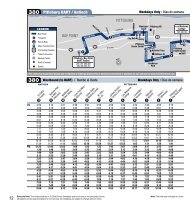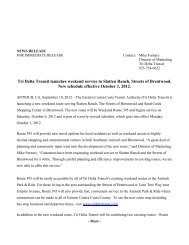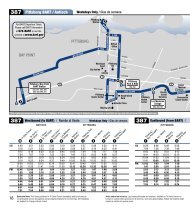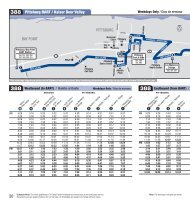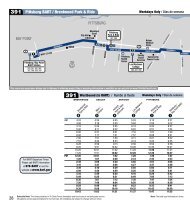to view Short Range Transit Plan FY 2007/2008 - Tri Delta Transit
to view Short Range Transit Plan FY 2007/2008 - Tri Delta Transit
to view Short Range Transit Plan FY 2007/2008 - Tri Delta Transit
You also want an ePaper? Increase the reach of your titles
YUMPU automatically turns print PDFs into web optimized ePapers that Google loves.
grade-separated bus ways. This kind of bus way tends <strong>to</strong> have thegreatest ridership, as demonstrated by the bus ways in Pittsburgh, theOttawa <strong>Transit</strong>way, and the El Monte Bus way in Los Angeles. Avariation on grade-separation is operation of extensive express busservices over high occupancy vehicle (HOV) lanes along freeways.Numerous examples exist in the Bay area including <strong>Tri</strong> <strong>Delta</strong> <strong>Transit</strong>Route 300; the Vallejo Baylink express buses along I-80 serving the ElCerri<strong>to</strong> Del Norte BART station and supplementing the Baylink ferries;the Golden Gate <strong>Transit</strong> commuter bus network serving Sonoma andMarin County commuters <strong>to</strong> down<strong>to</strong>wn San Francisco; AC <strong>Transit</strong>transbay buses; Samtrans express buses operating along U.S. 101;and a number of other operations. Numerous examples also exist inother U.S. cities, the most prominent in New York City and New Jersey(e.g., the Lincoln Tunnel bus lanes in<strong>to</strong> the Port Authority BusTerminal); the Shirley Highway from Virginia in<strong>to</strong> Washing<strong>to</strong>n, D.C.;the Hous<strong>to</strong>n <strong>Transit</strong> ways serving buses <strong>to</strong> down<strong>to</strong>wn Hous<strong>to</strong>n andvery large volumes of carpools and vanpools; HOV lanes/bus ways inDenver; and other U.S. cities.One drawback of HOV lanes along freeways for transit service is thatmidday transit volumes will be relatively low, mainly because freewaysare not located optimally for transit-oriented, walk able development,and such “all day” destinations favorable <strong>to</strong> transit are often wellbeyond walking distance from freeway alignments even in cases wheretransit stations are provided.BRT Options for Eastern Contra Costa CountyDetermining what BRT options may be feasible in the <strong>Tri</strong> <strong>Delta</strong> <strong>Transit</strong>service area first requires understanding the context of local transittravel patterns. According <strong>to</strong> the analysis in Table 4.1 developed fromon-board survey origin and destination data for “linked” transit trips,about 30% of <strong>Tri</strong> <strong>Delta</strong> <strong>Transit</strong> patrons stay within their immediatecommunity of origin, about 30% begin and end their trips at BART ortransfer between routes at BART, and the remaining 40% travelbetween communities within East County. These patterns, includingtrips <strong>to</strong> and from the Pittsburg/Bay Point BART station are showngraphically in Figure 4.19.Table 4.1 Estimated Weekday <strong>Transit</strong> <strong>Tri</strong>p Origins & DestinationsFROM / TO Brentwood Oakley Antioch Pittsburg Bay Point BART Other TOTALBrentwood 263 56 78 78 11 56 17 559Oakley 70 112 48 34 0 31 0 295Antioch 95 48 1,190 405 119 309 214 2,380Pittsburg 133 40 226 479 133 293 67 1,371Bay Point 35 0 70 210 140 280 35 770BART 120 40 519 333 253 0 67 1,332Other 0 0 168 84 38 0 0 290TOTAL 716 296 2,299 1,623 694 969 400 6,99778




